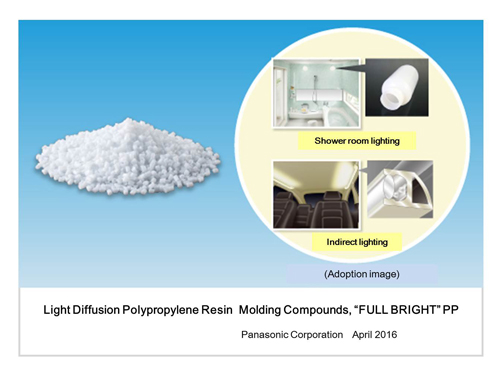Panasonic developed a light diffusion type polypropylene (PP) resin molding compounds for LEDs. This material will contribute to improve customer’s design flexibility with simple processing into complex shapes.
Osaka, Japan – Panasonic Corporation today announced that it has developed a light diffusion type polypropylene (PP) resin molding compounds[1], called “FULL BRIGHT”*1 PP, which can extend the operating life of LEDs. Mass-production of this new material, which is lightweight and provides higher brightness of LED lighting, will begin in April 2016. The industry’s first*2 introduction of a material applicable for injection stretch blow molding [2] enables the formation of complex shapes and contributes to greater product design freedom for customers.
For maintaining uniform illuminance, a diffusion plate is generally placed near LED lighting sources. The currently used material for diffusion plates often includes polycarbonate and acrylic resin. But in the diversified environment of LED light sources, further light resistance, chemical resistance [3], resistance to high temperature and high humidity, and also lighter weight are required for the diffusion plate material.Our product contributes to the long term use and lighter weight of LED lighting devices.
This new material has the following advantages.
- In addition to injection molding, this material can also be used for injection stretch blow molding process that was previously believed to be difficult using conventional light diffusion PP resin molding compounds, enabling customers to form complex shapes with greater freedom based on individual customer applications.
• Ability to produce 0.5-mm thick thin molding, which was previously unachievable; achieved less than 10% thickness accuracy by processing; company’s previously used material*3 generated a hole when a product was blown to a 0.5-mm thickness.
• Material flow rate (MFR) of 25 g/10 min; company’s previous material*3 was 20 g/10 min. - Conquered the previous weakness of light resistance of the conventional PP resin molding compounds and achieved excellent resistance to chemicals, high temperature and high humidity as well as water for extending the operating life of LED lighting.
• Light resistance: under an environment of 90°C + UV*4, discoloration after 90 days of exposure (approx. 2000 hours).
ΔE:2.0 or below, which is equivalent to ten years in outdoor environments; company’s previous material*3 was ΔE: 17. - Material characteristics of low specific gravity contribute to lightweight design of LED lighting devices.
• Specific gravity of 0.93, compared with polycarbonate 1.2; this material reduces product weight by 30% when produced in the same volume.
- *1) “FULL BRIGHT” is a trademark of the Panasonic Corporation.
- *2) As the light diffusion PP resin molding compounds applicable to injection stretch blow molding as of April 5, 2016 (surveyed by the company).
- *3) The conventional PP resin molding compounds.
- *4) UV radiation intensity 400W mercury lamp (30cm distance)
[Applications]
Examples include LED lighting fixtures that require highly refined styling and complex processing (automotive interior lighting, outdoor sign boards, store lighting, and water-related lighting), digital signage, etc.
[Remarks]
This material will be exhibited at the “Highly-functional Material World 2016” on April 6 to 8, 2016 at the Tokyo Big Site.
[Description of terms]
- [1] Light diffusion polypropylene resin molding compounds
- Polypropylene resin molding compounds in milky color diffuses light by filler, etc.
- [2] Injection stretch blow molding
- After the resin is molded into a test tube shape by an injection molding machine, the molded test-tube-shaped resin is further blown up in a different die to produce a bottle-shaped product.
- [3] Chemical resistance
- Change-resistant properties against appearance or physical characteristics when used in chemical substances.















